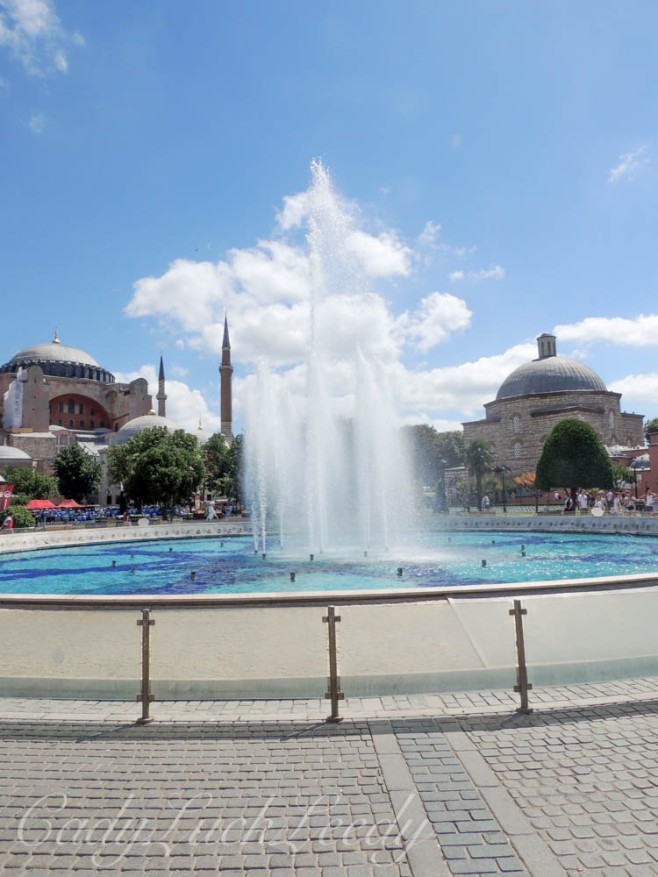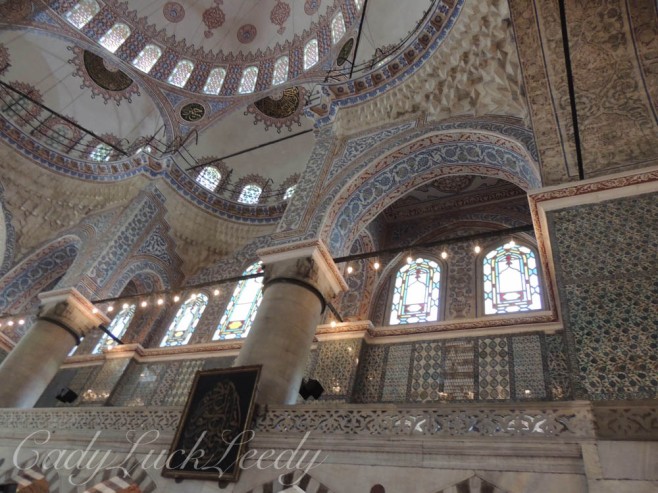The Blue Mosque and Neighborhood, Istanbul, Turkey
Just like Rome, Istanbul’s Old Town is built on seven hills. The district called Sultanahmet, on top of the first hill, is the historic city center. This site gave the Greeks control of three surrounding bodies of water; the Bosphorus Strait, the Golden Horn and the Sea of Marmara. Leaving Hagia Sophia at one end of Sultanahmet Park, we walk past the beautiful fountain where the arcs of water mimic the domes of Hagia Sophia.
Here the gardeners are busy planting new flowers in swirls of decorative display.
At the opposite end of the park is the Sultan Ahmed Mosque, known as the Blue Mosque, noted for the interior of blue paint and 20,000 rich, blue, handmade, ceramic tiles in fifty different tulip designs. The tiles at the lower level are traditional in design while the tiles at gallery level are flamboyant with exquisite flowers, fruit and cypresses. The upper floors are dominated by blue paint and more than 200 stained glass windows with intricate designs. In addition to the natural light there are massive chandeliers. Ostrich eggs were placed on the chandeliers to repel spiders and prevent cobwebs inside the mosque.
The Sultan’s Tale goes like this.
The Blue Mosque was built in six years from 1609-1616 by the architect, Mehmet Aga, who also built the giant black cube at the center of the mosque in Mecca, the holiest shrine of Islam. Sultan Ahmet I (1590-1617) ascended the thrown at the age of 14 and his greatest achievement was the construction of the Blue Mosque. To prevent future conflicts it was customary for a new sultan to kill his closest brother. Ahmet went against tradition and spared his brother Mustafa’s life. After Ahmet’s death from typhoid at the age of 28, in 1617, his 11 year old son Murat IV, became sultan and had his younger brother, Prince Beyazit strangled, which ended the new tradition and reverted to the old. Murat’s mother, Kösem, was one of the most influential women of her time. Following Ahmet’s death, for nearly a decade Kösem ruled the empire without intrusion because Murat IV, now the the sultan, ruled at such a young age. When Murat died, Kösem placed her grandson, Mehmet, as the next sultan. Mehmet’s mother, tired of Kösem’s domination, had Kösem strangled in her sleep by the eunuchs. And so the story goes.
Outside the Blue Mosque are six minarets. Only one is needed. The imam (prayer leader) or muezzin (a man noted for his talent in voicing the call to prayer) would climb to the top of the minaret five times a day to announce the call. Sultan Ahmet requested six minarets, to flaunt his wealth, but since there were six in Mecca, he had a seventh built in Mecca, as not to upstage the holy shrine.
Right outside the Blue Mosque is the Hippodrome, the spot for chariot races and a place where people gathered for social and religious disputes, political clashes and violent uprisings. Today there are market stalls here and at night families gather to eat and party.
The Egyptian Obelisk was carved 1500 years before the birth of Christ to honor the Egyptian Pharaoh Thutmose III, and to commemorate his military achievements. The obelisk was brought here from the Upper Nile and is only the upper one third of the original massive stone block. The base of the block was cut of local marble and the four sides tell the story of Theodosius the Great, and his family, as they sat here watching the chariot races at the Hippodrome.
The Column of Constantine was constructed in Istanbul. It was originally sheeted with bronze panels, but in the Fourth Crusade, (early 13th century) the city was looted and the panels stripped to make weaponry.
The Column of the Serpent was a victory monument dedicated to the 31 Greek city-states to commemorate their victory over the Persians at Plataea. (479 BC) Originally, this column showed three serpents twisted together, their heads supporting a golden trophy. The golden trophy is long gone and only the jaw of one snake still exists and it is in the Istanbul Archeological Museum. The Hippodrome also was the place of the famous four cast-bronze horses from ancient Greece. During the 4th Crusade they were plundered and taken to Venice, where they now reside at St Mark’s Basilica. (See a photo of them in my Venice posts)
The German Fountain was a gift from the German government to commemorate Kaiser Wilhelm II’s visit to Istanbul in 1898. It was constructed in Germany and transfered in pieces to Istanbul in 1901 and re-assembled on this location.
The Divan Yolu was the main thoroughfare in Byzantine times. The road started right here where the Golden Milestone still stands in a pit. 1500 years ago this was considered the point of the center of the world and it showed the distances to key locations within the empire.
Below ground, the Underground Cistern, was a vast reservoir that held water reserves for ever growing Istanbul. The cistern covers an area of two football fields and could hold 27 million gallons of fresh water. 336 columns support the brick ceiling, most of them coming from earlier Roman ruins. Clay pipes and aqueducts carried the water twelve miles to this cistern. Today the cistern is open to the public. The cistern is a shallow pond with a walkway around it. At the exit of the cistern a stage is in the water and serves as an exhibition hall for art festivals and concerts!
I hope you enjoyed the day at the Blue Mosque!































One Response to “The Blue Mosque and Neighborhood, Istanbul, Turkey”
Your photos are beautiful